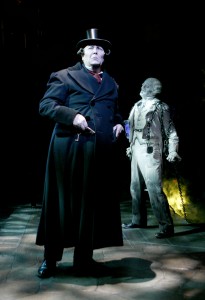A Christmas Carol: A Musical Ghost Story. adaptation by Jon Kimbell, North Shore Music Theatre, 12/2/11-12/23/11, http://www.nsmt.org/.
Reviewed by Craig Idlebrook
(Beverly, MA)
There are two types of Christmas displays you can create with those dangly lights from the hardware store. You can hang a string or two on a bush or you can cover every inch of your home’s exterior with sequenced glitz that spells out the lyrics of “Jingle Bells” and blinks a tableau of Santa feeding a reindeer. Either option can be beautiful or ugly, depending on how it’s done.
The same holds true with staging Charles Dickens’ A Christmas Carol. It can be staged as a quiet drama or as a Las Vegas spectacular. The producers of A Christmas Carol: A Musical Ghost Story at the North Shore Musical Theatre tended towards the latter, as evidenced by the need for stage hands to sweep off the piles of glitter at the end of the first act. At times, the special effects provided fun eye candy. But too often, the effects drowned out the sweetness of the story and the stellar performances of some of the cast.
Everyone knows the play, right? Miser gets scared straight by one ghost and three spirits to keep Christmas in his heart. It’s a morality play about correcting the excesses of capitalism by Dickens, which can make theatergoers uneasy in the commercial whirlwind of Christmas.
It’s fine to go to the hilt with the glitz, but such glam must augment the story, and here the high-voltage effects seems to bury it. The struggles of the Cratchit family, the sweet conscience of the story, are drowned out in the spectacle. It’s fun to watch the ghost of Jacob Marley zip around in the air and get dragged to hell like he’s trapped in a Sam Rami film, but Marley’s message can barely be heard above the din.
Despite this, director John MacInnis deserves credit for fostering several standout performances among the cast and ensuring that everyone is fluent speaking Dickens’ verbose language.
David Coffee is magnificent as Scrooge. By drawing out the befuddled center of Scrooge’s crabbiness, Coffee draws a moving portrait not of a man who lost his heart in old age, but of a hurt boy who never felt safe enough to love as he grew into manhood. It’s a character arc that makes Scrooge’s giddy payoff at the end inevitable and a joy to watch. Jeff Kuhr and Joe Moeller also are wonderful as the Pearlies, a pair of tumbling, dancing spirits who cue the supernatural action with their movements and pantomimes.
It’s interesting to note that MacInnis choreographed the Pearlies, which shows he knows much about how a story can be advanced by simple human movement. In future productions of this play, I hope he feels more comfortable relying on his evident directorial skills to draw out the humanity of a script, and he can leave out at least a few pounds of glitter.

